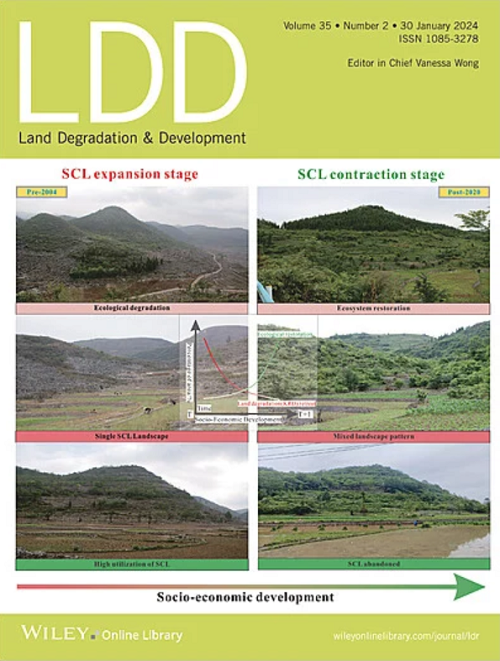间作和绿肥还田通过诱导土壤酶活性和微生物群落的变化缓解水稻砷污染
IF 3.6
2区 农林科学
Q2 ENVIRONMENTAL SCIENCES
引用次数: 0
摘要
砷(As)积累植物被用于单作或间作,以修复受污染的土壤,但其富含As的生物量会带来环境风险。利用这些生物质作为绿肥是一种很有前途的策略,可以改善土壤健康、作物产量和微生物多样性。然而,其对糙米抗逆性和砷积累的影响尚不清楚。研究了砷积累植物单作和间作产生的5种绿色肥料对砷污染土壤中糙米生理和土壤微生物群落的影响。施用绿肥显著提高糙米产量(25.42 ~ 39.53 g/株),缓解生理胁迫。氧化应激相关酶(过氧化氢酶、超氧化物歧化酶和过氧化物酶)活性分别降低了38.70%、40.13%和37.30%,丙二醛含量降低了48.46%。绿肥还改善了土壤的理化性质,包括pH、阳离子交换容量(CEC)和土壤有机质(SOM),同时降低了土壤有效态砷(As)浓度。这些改善伴随着土壤酶活性(β -葡萄糖苷酶、蛋白酶、脲酶和酸性磷酸酶)的增强和微生物群落组成的明显变化。Proteobacteria和Chloroflexi的相对丰度下降,而Nitrospira、Sphingomonas、Acidibacter、Rokubacteriales、Pedomicrobium、Nocardioides、Saccharimonas、Terrimonas、Haliangium和Flavobacterium的相对丰度增加。这些类群与土壤As浓度呈显著负相关,与pH、CEC、SOM和土壤酶活性呈显著正相关。植物修复后生物量产生的绿肥提高了糙米的抗逆性、产量、土壤质量和有益微生物数量。这种方法提供了一种可持续的方式来减少作物轮作系统的风险和提高生产力。本文章由计算机程序翻译,如有差异,请以英文原文为准。
Intercropping and Green Manure Return Mitigate Arsenic Contamination in Rice via Induced Shifts in Soil Enzymatic Activities and Microbial Communities
Arsenic (As)‐accumulating plants are used in monoculture or intercropping to remediate contaminated soils, but their As‐rich biomass poses environmental risks. Using this biomass as green manure is a promising strategy to improve soil health, crop yield, and microbial diversity. However, its effects on stress tolerance and As accumulation in brown rice remain poorly understood. This study investigates the impact of five green manures derived from monoculture or intercropping of As‐accumulating plants on brown rice physiology and soil microbial communities in As‐contaminated soil under crop rotations. The application of green manure significantly increased brown rice yield (25.42–39.53 g/plant) and alleviated physiological stress. Activities of oxidative stress‐related enzymes (catalase, superoxide dismutase, and peroxidase) were reduced by 38.70%, 40.13%, and 37.30%, respectively, along with a 48.46% decrease in malondialdehyde content. Green manure also improved soil physicochemical properties, including pH, cation exchange capacity (CEC), and soil organic matter (SOM), while reducing available soil As concentration. These improvements were accompanied by enhanced soil enzyme activities (β‐glucosidase, protease, urease, and acid phosphatase) and distinct shifts in microbial community composition. Notably, the relative abundances of Proteobacteria and Chloroflexi decreased, while Nitrospira, Sphingomonas, Acidibacter, Rokubacteriales, Pedomicrobium, Nocardioides, Saccharimonas, Terrimonas, Haliangium , and Flavobacterium increased. These taxa exhibited strong negative correlations with soil As concentrations and positive associations with pH, CEC, SOM, and soil enzyme activities. Green manure from postphytoremediation biomass improved brown rice stress resilience, yield, soil quality, and beneficial microbial populations. This approach offers a sustainable way to reduce As risks and boost productivity in crop rotation systems.
求助全文
通过发布文献求助,成功后即可免费获取论文全文。
去求助
来源期刊

Land Degradation & Development
农林科学-环境科学
CiteScore
7.70
自引率
8.50%
发文量
379
审稿时长
5.5 months
期刊介绍:
Land Degradation & Development is an international journal which seeks to promote rational study of the recognition, monitoring, control and rehabilitation of degradation in terrestrial environments. The journal focuses on:
- what land degradation is;
- what causes land degradation;
- the impacts of land degradation
- the scale of land degradation;
- the history, current status or future trends of land degradation;
- avoidance, mitigation and control of land degradation;
- remedial actions to rehabilitate or restore degraded land;
- sustainable land management.
 求助内容:
求助内容: 应助结果提醒方式:
应助结果提醒方式:


